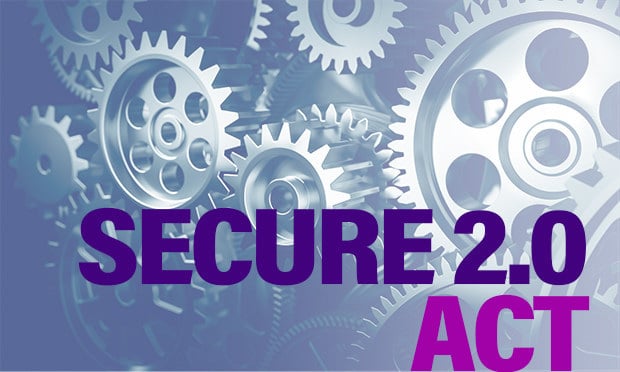 SECURE 2.0 Act
SECURE 2.0 Act
More than a third (38%) of Americans say not having enough money saved for retirement is among their most significant sources of financial stress. New workplace retirement savings plan rules could help, especially for those working for smaller employers.
Setting Every Community Up for Retirement Enhancement (SECURE) 2.0, passed in December 2022, builds on 2019 legislation that laid the foundation for American workers to better save for retirement. The new legislation includes several provisions designed to incentivize employers to offer workplace retirement plans, promote employee participation and encourage stronger contribution activity.
Recommended For You
Related: Guiding retirement savers in 2023: New opportunities abound from SECURE 2.0
The Cerulli Edge—U.S. Retirement Edition report outlined some of the new provisions and how and when they will impact employers:
- Auto-enrollment and auto-escalation provisions within SECURE 2.0 will perhaps be the biggest catalyst for helping American workers accumulate wealth for retirement, according to Cerulli. Auto-enrollment will be mandatory starting in 2025 for all new 401(k) and 403(b) plans, which will primarily be with smaller companies since most larger companies already offer them. Enrollment amounts will span from 3% to 10% of annual salary, increasing 1% annually until an individual's contribution reaches 10%, but not to exceed 15%. Employees will be able to opt out if they choose, and some businesses will be exempt, including those employing fewer than 10 people as well as church and government plans.
- Auto-portability also could help employees build retirement savings by allowing them to transfer their retirement assets from one plan sponsor to another, mitigating plan leakage. Some plan sponsors currently enact force-out and cash-out provisions on accounts with smaller balances. The legislation raises the upper threshold for these provisions and helps ensure that funds are more appropriately invested and incur fewer fees by allowing them to roll into the new employer's plan rather than rolling into a default IRA. Cerulli estimates that $115 billion of DC assets eligible for distribution were cashed out in plan year 2021.
- SECURE 2.0 will allow increased catch-up contributions for those aged 60 to 63 years by contributing the greater of $10,000 or 150% of the standard catch-up limit, adjusted for inflation. For individuals who earn more than $145,000 annually, these catch-up contributions must be applied toward their Roth accounts with after-tax dollars, which may present administrative challenges for plan sponsors and recordkeepers. Some plan administrators will have to add a Roth option to their plan if they don't already have one and they will also have to keep track of participants in this age group and notify them of the catch-up option.
- Many employees are currently foregoing saving for retirement while they work to pay off student debt. SECURE 2.0 will allow employers to make matching contributions to their 401(k) accounts to match payments individuals make to qualifying student loan payments. Cerulli finds more than half of participants under age 40 contribute 6% or less of their income to their 401(k)s, and student loan debt is the top source of financial stress for 17% of participants in their 20s and 12% of participants in their 30s. The average borrower takes about 20 years to repay their loan so the cumulative impact of these payments becomes a major obstacle when saving for retirement.
- SECURE 2.0 also will allow plan sponsors to offer emergency savings accounts, designated as Roth accounts, to certain employees and make matching contributions. This feature gives employees more flexibility to prepare for unforeseen events without having to tap into their qualified accounts for funds.
- Other provisions include allowing 403(b) plans to join multiple employer plans (MEPs), providing tax credits for employees who start workplace retirement plans, and making it easier to incorporate guaranteed income components into plans.
 Join our LinkedIn group, ALM's Small Business Adviser, a space where small business owners can gather to network, have discussions and keep up with the trends and issues affecting their industries.
Join our LinkedIn group, ALM's Small Business Adviser, a space where small business owners can gather to network, have discussions and keep up with the trends and issues affecting their industries. The Cerulli study also asked DC consultants which investments their firm is most likely to recommend to DC plan clients as an in-plan retirement income option; 68% said target-date series with a guaranteed income component followed by 50% indicating target-date series with an income vintage, 36% pointing to a multi-asset-class managed payout strategy, and 9% each choosing standalone in-plan annuity products or a fixed income strategy. Respondents were allowed to select up to two options. "Dividend-yielding equity strategy" and "I would not recommend an in-plan retirement income product/solution" were options but were not selected.
Kristen Beckman is a freelance writer based in Colorado. She previously was a writer and editor for ALM's Retirement Advisor magazine and LifeHealthPro online channel.
© Touchpoint Markets, All Rights Reserved. Request academic re-use from www.copyright.com. All other uses, submit a request to [email protected]. For more inforrmation visit Asset & Logo Licensing.






